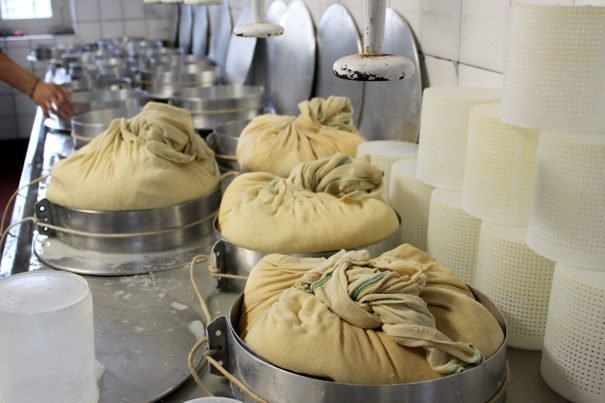
The Perfect Breakfast for the Milk‑Averse Cheese Enthusiast

The Perfect Breakfast for the Milk‑Averse Cheese Enthusiast
Cheese in Northern Italy
I’m not a big fan of milk. I’d rather start the day with a large cup of filter coffee or an espresso rather than a creamy cappuccino. Yet, I love cheese and other milk-like things. So, when I was invited to have breakfast at the cheese factory in Muris, a small village in Friuli Venezia Giulia, I was thrilled: mountain cottage cheese and fresh-made ricotta instead of cereals and pastries? Oh yes.
Muris has what is known as a “shift cheese factory” or latteria turnaria: latteria is the local term for cheese dairy; turnaria signifies that people take turns to work it in shifts. Functioning both as a cooperative farm and social institution, it’s one of the few that remain in the region. This one is also a great place to have breakfast.
As we get there around 9 a.m., the cheese-making is almost done. The experienced dairyman arrived many hours earlier to turn on the gas fire to heat the milk and to clean the previous day’s wheels of cheese. The women shaping and pressing the fresh cheese have also been here for hours. They come in shifts to help the dairyman transform milk into delicious cheese, ricotta, yogurt, butter, and more.
Officially established in 1880 by a Royal Decree, the cooperatives started out as a clever model of community farming and soon became a social hub. Muris’s one was established in 1920, although the current building only dates back to the 1970s.
Every family had at least one cow, for the milk—too much to drink it all, not enough for serious cheese production. So villages pooled their resources to produce cheese and other products, incorporating the knowledge of an expert dairyman who created recipes and handed them down. Farmers—often women, young girls, or widows—took turns bringing milk to the factory and assisting the dairyman. Each family received the cheese made from the milk they brought, or the money from selling it on.
Over the years, these cooperatives became the villages’ main gathering point. Women came to the factories carrying milk cans and singing; men worked, discussed village affairs, and looked for potential wives there.
Much has changed. Many of these latterias have shut down. After the 1976 earthquake destroyed part of the region, locals seized the opportunity to switch from a rural economy to a modern one, with the help of reconstruction funds. Now, there are different challenges. People complain about the falling price of milk, and the effect of E.U. regulations on the traditional techniques employed to make the cheese.
In Muris, visitors are welcome to buy cheese or enjoy a brief tour ending with a sumptuous breakfast. We taste an intense, golden, yellow butter for bread with homemade jams. A creamy yogurt. A stunning cows’ ricotta, made with the whey from the cheese-making, no added cream. And of course, cheese: several wheels of it, of varying ages, with milky flavors ranging from freshness to richness. Definitely much better than a cappuccino.